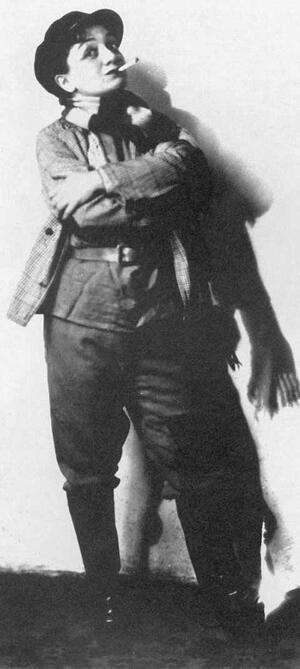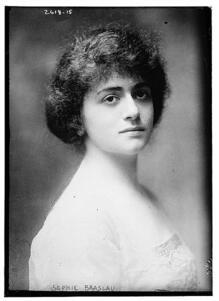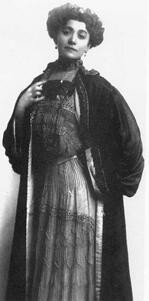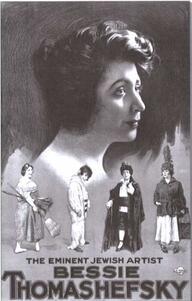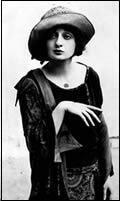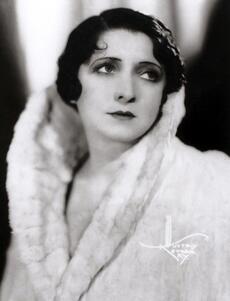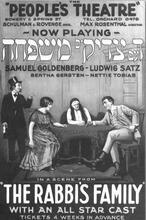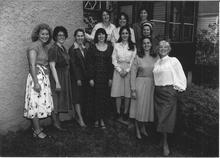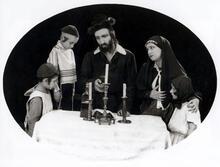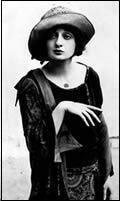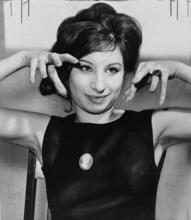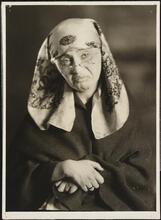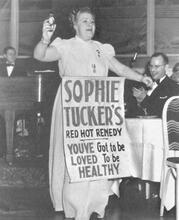Yiddish Musical Theater in the United States
Jewish women on stage in America took on a variety of musical roles and performed all kinds of songs, including religious hymns and liturgical chants. Female performers were regularly featured on Yiddish theater posters and commercial sheet music, reflecting the preponderance of central female characters in the Yiddish stage repertoire. In its heyday, the Yiddish stage mirrored American Jewish life. Family matters had particular importance in that area of immigrant accommodation and acculturation to American life, and the nobility of motherhood was celebrated in legions of stories and songs. An amazing range of women’s woes were highlighted, discussed, and often resolved across the footlights, presenting the reality that immigrant women faced to an extent not paralleled in the English-language theatrical world during those years.
European Antecedents
From 1876 to the early 1880s, operettas, plays that combined spoken dialogue, music, songs, and dances on a light topic or theme, became popular in Jewish communities in Russia, Romania, Austria, and Poland. Beginning with some of his earliest productions, Avrom Goldfaden, the self-styled “father” of Yiddish theater, devised operettas for his troupes of singer-actors and instrumentalists. As this new genre of theater became more popular, it gradually began to feature women playing the female roles instead of young boys. By the 1880s, as the center of gravity for Yiddish theater shifted westward, Yiddish operettas and their artists began to immigrate to America.
Migration to America
Jewish women on stage in America took on a variety of musical roles and songs, including religious hymns and liturgical chants. Sophie Karp (formerly Sara Siegel Goldstein), who had been discovered and trained for the stage by Goldfaden, became a popular actress in Yiddish revues and shows at the Bowery theaters on the Lower East Side of New York City. In 1896, she introduced a Yiddish ballad written especially for her by musician Peretz Sandler. That song, a dramatic arietta called “Eli, Eli,” soon became a featured solo of many other female performers of the day, even outside strictly Jewish performing spaces. Operatic sopranos Sophie Braslau and Rosa Raissa sang it at the old Metropolitan Opera House and in concert halls. Belle Baker featured it in her touring vaudeville presentations, and her photograph adorns several published editions of the song. For years, the song was associated with female singers, until Cantor Yossele Rosenblatt made “Eli, Eli” a part of his repertoire and other male singers began to follow suit.
One of the most famous singers of “Eli, Eli” was Bertha Kalich, a Yiddish stage actor whose performances were widely acclaimed by English-speaking and Yiddish-speaking critics alike. She started her career on the New York City Bowery stages then moved to theaters on Second Avenue and Broadway, playing Yiddish versions of the female protagonists in plays by Tolstoy, Dostoyevsky, Schiller, Ibsen, and Shakespeare. All of Kalich’s roles involved music. In the early days of the Yiddish theater, music was predominant throughout the repertoire and virtually everyone on the Jewish stage had to sing.
Regina Prager was among the best-known early Yiddish female singer-actors. In fact, Goldfaden wrote several operettas featuring heroic women specifically for her. In the course of her long career, Prager introduced characters such as Shulamis, whose loyalty represents the nature of the Jewish people’s relationship to God, and Dinah, the warrior consort of the second-century Jewish rebel Simon Bar Kokhba. Over the years, Prager went from a soubrette and leading lady to playing formidable matrons, such as her leading role in Boris Thomashefsky’s musical Di Khazinte [The female cantor]. Her photographs adorned the covers of an entire series of special solo song selections. Indeed, female performers were regularly featured on Yiddish theater posters and commercial sheet music, reflecting the preponderance of central female characters in the Yiddish stage repertoire.
By 1910, resourceful Yiddish theatrical entrepreneurs were presenting their own versions of “uptown” American musicals from Broadway. Bessie Kaufman Thomashefsky starred as the “Jewish American Beauty” in her husband Boris Thomashefsky’s production of The Yiddish Yankee Doodle. After her marriage dissolved, she continued a busy theatrical life—directing, producing, and acting in her own shows. She was one of several actresses to build careers that started on the stage but grew to include directing and producing plays.
While Jacob P. Adler was the most well-known theatrical star of his day, the Adler women were also exceptional talents and major stars in their own right. Adler’s daughter Celia (Cili Feinman) Adler enjoyed a long and varied stage career. His third wife, Sara Heine Adler, and their daughter, the widely acclaimed performer and teacher Stella Adler, both appeared in dramatic roles past their eightieth birthdays. Stella Adler moved from the Yiddish stage to the English-language stage and made her mark on the American stage as an influential acting teacher.
Mirroring American Jewish Life on Stage
In its heyday, the Yiddish stage mirrored American Jewish life, depicting many issues that directly affected audiences. Family matters had particular importance in that era of immigrant accommodation and acculturation to American life. The nobility of motherhood was celebrated in legions of stories and songs. How could it be possible, balladeers sang, that one mother could take care of ten children, and yet ten children would not take care of one mother? An amazing range of women’s woes were highlighted, discussed, and often resolved across the footlights, presenting the reality that immigrant women faced to an extent not paralleled in the English-language theatrical world during those years. Some writers took a comedic approach in songs and stories about suffragettes and women’s rights issues, at a time when the idea of female doctors, politicians, rabbis, and cantors was mocked. Many other musical plays, however, were serious expositions, such as the productions on behalf of movements for women’s labor regulations that followed the Triangle Shirtwaist Fire in 1911, in which 146 people, mostly women, lost their lives.
Jennie Goldstein was a particular favorite on the Yiddish musical stage. Goldstein was known for performing characters of lonely women struggling to survive under great adversity. She began her career portraying a vulnerable immigrant waif, then played a wronged maiden who must give away her baby, a girl with the “stained past,” and an exhausted working girl who pleads “take me away from the sewing machine.” Other roles over the years included the victim of a bad husband, a deserted wife with sickly children who becomes an unappreciated, self-sacrificing middle-aged mother, and finally an abandoned and penniless old woman. Her photographs in these roles appeared on numerous sheet music covers and souvenir programs, and she filled crowded theaters with teary audiences.
Two highly popular comic-soubrettes who enjoyed long and illustrious careers on the Yiddish stage were Nellie Casman and Molly Picon. Casman, whose humorous style was naughty yet wise, wrote much of her own theatrical material and songs. One of her tunes, “Yosl, Yosl” [Joseph, Joseph] and its English version, “Joseph, Make Your Mind Up,” continues to be sung by performers worldwide. In late 1939, Casman concluded a successful year-long European tour, fleeing by train from Berlin after a performance in that city. It was an experience she would vividly recall to the end of her life.
Molly Picon was arguably the most beloved performer on both the Yiddish and the general stage. She played many of her most famous early roles in drag as a rebellious young boy. Her delightful characterizations were shaped by a petite physical appearance and warm personal charm. Many of the songs she presented on stage and in recordings were written by three leading composers of Yiddish music theater: Joseph Rumshinsky, Sholom Secunda, and Abraham Ellstein. Picon also made several highly influential Yiddish movies. Her illustrious Yiddish stage and screen career was followed by an equally successful career on Broadway, and to a lesser extent in Hollywood and on television. A gifted and versatile star in Yiddish and English for decades, she appeared on stage, in films, and on television almost to the end of her life.
Although their performances were often associated in style, genre, and content with Yiddish theater, neither Fanny Brice nor Sophie Tucker ever appeared formally on the Yiddish stage. There were some women, such as Rhea Silberta, who composed songs for Yiddish musicals, generally for their own performances. One leading female composer was Mana-Zucca (Augusta Zuckerman), who also had a long career in American music before she came to the Yiddish stage. Among her compositions were Rakhem [Mercy] and Shalom Aleykhem [Greetings/Peace to you], the published editions of which were dedicated to soprano Rosa Raissa.
By the second half of the twentieth century, many of the distinctive qualities of Yiddish theater had mainstreamed into American life, as many Yiddish theater actors “crossed over” into mainstream American theater and Hollywood film. While some Yiddish artists and their artistry found new audiences in radio, movies, and television, the characters and styles of Yiddish theater abided and were even strengthened in broader venues of entertainment and cultural expression. Nevertheless, a number of highly talented performers and creative figures stayed within the ranks of Yiddish theater, at least for a few decades. Many were women, acting and singing, composing and writing, directing and producing.
Green, Stanley. Encyclopaedia of the Musical Theatre. New York: Dodd Mead, 1976.
Heskes, Irene. The Music of Abraham Goldfaden: Father of the Yiddish Theater. New York: Tara Publications, 1990.
Heskes, Irene. Passport to Jewish Music: Its History, Traditions, and Culture. New York: Tara Publications, 1994.
Heskes, Irene. Yiddish American Popular Songs, 1895 to 1950. Washington, DC: Library of Congress, 1992.
Landis, Joseph C., ed. Memoirs of the Yiddish Stage. Flushing, NY: Queens College Press, 1984.
Lifson, David S., trans. and ed. Epic and Folk Plays of the Yiddish Theatre. Rutherford, NJ: Fairleigh Dickinson University Press, 1975.
Sanders, Ronald. The Downtown Jews: Portraits of an Immigrant Generation. New York: Harper & Row, 1969.
Sandrow, Nahma. Vagabond Stars: A World History of Yiddish Theater. New York: Harper & Row, 1977.
Rosenfeld, Lulla Adler. Bright Star of Exile: Jacob Adler and the Yiddish Theatre. New York: Thomas Y. Crowell Company, 1977. Rev. ed., The Yiddish Theatre and Jacob P. Adler. New York: Shapolsky Publishers, 1988.
Slobin, Mark. Tenement Songs: The Popular Music of the Jewish Immigrants. Urbana, IL: University of Illinois Press, 1982.

